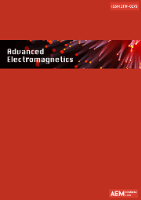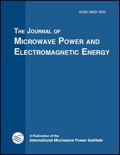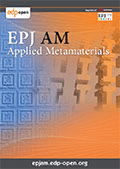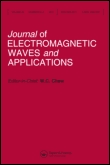
Progress in Electromagnetics Research M
Scope & Guideline
Unveiling the Potential of Electromagnetic Technologies
Introduction
Aims and Scopes
- Antenna Design and Optimization:
Research on various types of antennas, including MIMO, UWB, and wearable antennas, focusing on improving gain, bandwidth, and specific applications like 5G and biomedical devices. - Metamaterials and Their Applications:
Exploration of metamaterials for achieving unique electromagnetic properties, including filtering, absorption, and guiding of electromagnetic waves, with applications in radar and communication systems. - Electromagnetic Compatibility and Safety Analysis:
Studies addressing the compatibility of electromagnetic devices, including assessments of electromagnetic interference and safety standards for human exposure. - Signal Processing and Smart Antenna Systems:
Development of advanced signal processing techniques for MIMO and beamforming systems, enhancing the performance of radar and communication systems. - Numerical Modeling and Simulation Techniques:
Innovative numerical methods for simulating electromagnetic phenomena, including scattering, wave propagation, and material characterization. - Wireless Power Transfer Technologies:
Research focused on the design and optimization of systems for efficient wireless power transfer, addressing challenges in various applications such as electric vehicles and medical devices. - Biomedical Applications of Electromagnetics:
Utilization of electromagnetic principles in medical diagnostics and treatment, including imaging techniques and sensors for health monitoring.
Trending and Emerging
- 5G and Beyond Technologies:
A significant increase in research related to 5G communications and future wireless technologies, focusing on MIMO antennas, signal processing, and network optimization. - Integration of AI and Machine Learning:
Emerging themes include the application of AI and machine learning in optimizing antenna design and signal processing, highlighting a trend towards intelligent systems in electromagnetics. - Wearable and Flexible Electronics:
Growing interest in developing wearable antennas and sensors for health monitoring and IoT applications, driven by the demand for flexible and biocompatible materials. - Advanced Metamaterials and Photonic Devices:
Research focusing on innovative metamaterial designs and photonic devices that manipulate electromagnetic waves for applications in sensing, communications, and imaging. - Wireless Power Transfer Innovations:
Increased focus on novel techniques for efficient wireless power transfer, particularly for electric vehicles and biomedical implants, reflecting the need for sustainable energy solutions. - Biomedical Electromagnetic Applications:
Emerging research on the use of electromagnetics in medical diagnostics and treatment, including novel imaging techniques and biosensors, indicating a growing intersection of healthcare and technology.
Declining or Waning
- Traditional RF Circuit Design:
Research on conventional RF circuit design methodologies has decreased, possibly due to the industry's shift towards more integrated and application-specific solutions. - Low-Frequency Electromagnetic Studies:
There is a noticeable decline in studies focusing on low-frequency electromagnetic applications, as the emphasis has moved towards higher frequency and microwave applications, particularly in 5G and beyond. - General Electromagnetic Theory:
Papers dedicated to fundamental electromagnetic theory without specific applications are becoming less frequent, indicating a trend towards applied research with practical implications. - Static Electromagnetic Field Analysis:
Research focusing solely on static fields has waned, as dynamic and time-varying field analyses are increasingly prioritized for modern applications. - Conventional Material Characterization:
Traditional methods of material characterization using basic electromagnetic principles are less common, with a shift towards advanced techniques involving metamaterials and nanostructures.
Similar Journals

IEEE Letters on Electromagnetic Compatibility Practice and Applications
Bridging Theory and Practice in EMC.IEEE Letters on Electromagnetic Compatibility Practice and Applications is a reputable journal published by the IEEE-Institute of Electrical and Electronics Engineers Inc., focusing on the critical and dynamic field of electromagnetic compatibility (EMC). This journal provides a vital platform for researchers, professionals, and students to disseminate their findings on the practical applications and theoretical advancements related to EMC. With the increasing reliance on electronic systems in various industries, the significance of mastering electromagnetic compatibility cannot be overstated. Although there is no official impact factor listed yet, the journal is committed to maintaining a high standard of scholarly excellence. With its open access model, it ensures that groundbreaking research is freely available to the global community, promoting collaboration and innovation in the field. The journal's focus on real-world applications makes it a crucial resource for those looking to stay at the forefront of electromagnetic research and practice.

Visnyk NTUU KPI Seriia-Radiotekhnika Radioaparatobuduvannia
Fostering Collaboration in Radio Engineering ExcellenceVisnyk NTUU KPI Seriia-Radiotekhnika Radioaparatobuduvannia is a distinguished open-access journal published by the National Technical University of Ukraine, Kyiv Polytechnic Institute. Since its inception in 2009, the journal has been a vital platform for disseminating innovative research findings in the fields of radio engineering, electronic technology, and the development of radio apparatus. With its commitment to providing unrestricted access to high-quality scientific content, the journal aims to foster collaboration and knowledge exchange among researchers, practitioners, and educators both in Ukraine and globally. While the journal's H-index and Scopus rankings are currently not provided, its growing reputation in the academic community is indicative of its impact in advancing technology and engineering practices. The journal's accessibility ensures that cutting-edge research is available to a wide audience, making it a crucial resource for professionals and students seeking to stay informed about the latest advancements in radio technology and engineering.

Advanced Electromagnetics
Empowering Innovation in Electromagnetic ResearchAdvanced Electromagnetics, published by ADVANCED ELECTROMAGNETICS, GEEPS-SUPELEC, is an esteemed open access journal dedicated to the rapidly evolving fields of electrical and electronic engineering, as well as materials science, encompassing electronic, optical, and magnetic materials. With an ISSN of 2119-0275 and an established presence since 2012, the journal facilitates the dissemination of high-quality research and advancements, making substantial contributions to the scientific community. Operating from France, the journal proudly holds a Q3 quartile ranking in Electrical and Electronic Engineering for 2023, alongside rankings in Radiation and Electronic Materials. With a commitment to fostering innovation and interdisciplinary collaboration, Advanced Electromagnetics appeals to a broad audience of researchers, professionals, and students, encouraging them to share work that propels the field forward. Enjoy the seamless accessibility of research articles under an Open Access model, allowing for widespread dissemination and engagement with cutting-edge advancements in electromagnetics.

Progress in Electromagnetics Research-PIER
Catalyzing Breakthroughs in Electrical EngineeringProgress in Electromagnetics Research-PIER, published by EMW PUBLISHING, is an esteemed academic journal that stands at the forefront of the fields of Condensed Matter Physics, Electrical and Electronic Engineering, and Radiation. With an impressive impact factor reflected in its Q1 quartile rankings across these disciplines, PIER serves as a critical platform for disseminating high-quality research findings and advancements from 2000 onwards, with the latest contributions expected through 2024. The journal's commitment to excellence is evident as it holds prominent positions in Scopus rankings, including a remarkable 95th percentile in the field of Radiation. Researchers, professionals, and students will find PIER invaluable for accessing cutting-edge topics and methodologies that push the boundaries of electromagnetics research. For facile access, the journal is published in both ISSN (1070-4698) and E-ISSN (1559-8985) formats, ensuring that vital knowledge is readily available to its audience.

Advances in Radio Science
Fostering Collaboration in Electronic AdvancementsAdvances in Radio Science, published by COPERNICUS GESELLSCHAFT MBH, is a leading open-access journal established in 2003, dedicated to the rapid dissemination of high-quality research in the field of radio science, particularly focusing on advancements in electrical and electronic engineering. With an ISSN of 1684-9965 and an E-ISSN of 1684-9973, this journal is indexed and provides an avenue for researchers to contribute to the latest developments and innovations within the domain. Despite its current Q4 ranking in the Electrical and Electronic Engineering category, its commitment to open access ensures that all published articles are freely available to a global audience, fostering collaboration and knowledge sharing among engineers, researchers, and students alike. Situated in Göttingen, Germany, the journal continues to evolve and expand its reach, with content converging until 2024, emphasizing its relevance in a rapidly changing technological landscape. Whether you're a seasoned researcher or an emerging scholar, Advances in Radio Science invites you to explore the frontiers of radio science and contribute to its growing body of knowledge.

IEEE Journal of Electromagnetics RF and Microwaves in Medicine and Biology
Exploring the future of RF and microwave applications in health.IEEE Journal of Electromagnetics RF and Microwaves in Medicine and Biology is a premier journal dedicated to advancing the frontiers of research in the interdisciplinary domains of electromagnetics and biomedical applications. Published by the renowned IEEE-INST ELECTRICAL ELECTRONICS ENGINEERS INC in the United States, this journal holds a distinguished reputation, exemplified by its Q1 rankings in the fields of Instrumentation and Radiation, as well as a solid Q2 ranking in Radiology, Nuclear Medicine, and Imaging for 2023. Covering a wide spectrum of topics—from RF and microwave technologies to their applications in medical diagnostics and treatment—the journal aims to foster collaboration among researchers, practitioners, and educators. With a commitment to high-quality peer-reviewed content and a strong impact factor reflecting its extensive reach in the field, the IEEE Journal of Electromagnetics RF and Microwaves in Medicine and Biology serves as an essential resource for professionals and scholars who seek to bridge the gap between engineering and medical sciences. Researchers looking to access cutting-edge findings can benefit from the journal's engagement with contemporary issues in health technology, enhancing both academic and practical knowledge in the evolving landscape of medical electromagnetics.

JOURNAL OF MICROWAVE POWER AND ELECTROMAGNETIC ENERGY
Catalyzing Collaboration in Cutting-edge Electromagnetic ResearchThe Journal of Microwave Power and Electromagnetic Energy, published by Taylor & Francis Inc, is a premier scholarly journal dedicated to the advancement of research in the fields of microwave power and electromagnetic energy. With a strong focus on innovative applications and theoretical developments, this journal serves as a vital platform for researchers, professionals, and students alike, fostering collaboration and dissemination of cutting-edge findings since its inception in 1985. Although currently categorized in the Q3 and Q4 quartiles across various disciplines such as Ceramics and Composites, Electrical and Electronic Engineering, and Condensed Matter Physics, the journal consistently emphasizes both experimental and computational methodologies. As part of its commitment to excellence, the journal is indexed in Scopus, boasting a rank of #76 in Metals and Alloys and a percentile standing that reflects its niche yet significant role in the scientific community. While the journal does not offer Open Access options, it remains an essential resource for those invested in the evolving landscape of microwave technology and electromagnetic energy research, with converged years extending through 2024. Researchers are encouraged to contribute impactful articles that can inspire breakthroughs and fuel further inquiries in this dynamic field.

EPJ Applied Metamaterials
Empowering Discovery in Materials Science and MechanicsEPJ Applied Metamaterials, published by EDP SCIENCES S A, is a leading open-access journal dedicated to the dynamic field of metamaterials and their applications in various domains of physics and engineering. Since its inception in 2014, this journal has provided a vital platform for researchers to share innovative findings and advancements, facilitating the widespread dissemination of knowledge in Condensed Matter Physics, Materials Science, and Mechanics of Materials. With an impressive trajectory towards becoming a significant resource for academia and industry alike, EPJ Applied Metamaterials has achieved a commendable Q3 ranking in relevant categories according to the 2023 metrics, indicating its increasing impact within the scientific community. The journal is committed to fostering open dialogue and collaboration through its open-access model, ensuring that all research is freely accessible to a global audience. Scholars, professionals, and students alike are invited to contribute to this evolving field, harnessing the journal as a means to influence both theoretical and applied metamaterial research.

JOURNAL OF ELECTROMAGNETIC WAVES AND APPLICATIONS
Fostering Collaboration in Electromagnetic ResearchJournal of Electromagnetic Waves and Applications, published by Taylor & Francis Ltd, is a prestigious interdisciplinary journal that focuses on the rapidly evolving fields of electromagnetic waves and their applications. Since its inception in 1987, this journal has served as a vital resource for researchers, practitioners, and students interested in the latest advancements in electrical and electronic engineering, as well as materials science. The journal holds a respectable Q3 ranking in Electrical and Electronic Engineering and Electronic, Optical, and Magnetic Materials, and Q2 in Physics and Astronomy according to the 2023 category quartiles. With a dedicated readership, it aims to publish high-quality research articles that foster innovation and knowledge sharing among the scientific community. Despite not being open access, the journal ensures widespread availability of its insightful content aimed at pushing the boundaries of knowledge in the electromagnetic spectrum. As a crucial platform for disseminating cutting-edge research, the Journal of Electromagnetic Waves and Applications continues to contribute significantly to the advancement of technology and materials science.

Journal of Electromagnetic Engineering and Science
Pioneering Insights in Electrical and Communication TechnologiesThe Journal of Electromagnetic Engineering and Science (ISSN: 2671-7255, E-ISSN: 2671-7263) is a premier Open Access journal published by the Korean Institute of Electromagnetic Engineering & Science. Since its establishment in 2001, it has been dedicated to advancing knowledge in the fields of Electrical Engineering, Electromagnetic Theory, and Communications, making significant contributions to both academia and industry. The journal holds an impressive Q2 quartile ranking in notable categories such as Computer Networks and Communications and Electrical and Electronic Engineering as of 2023, reflecting its robust scientific impact and reputation. It is indexed in Scopus, with commendable rankings in multiple fields, enhancing its visibility and reach among researchers. The journal's open-access model ensures that cutting-edge research is accessible to a global audience, fostering collaboration and innovation. Researchers, professionals, and students in the domain are encouraged to contribute and engage with high-quality articles that cover the latest advancements and trends in electromagnetic engineering and associated sciences.